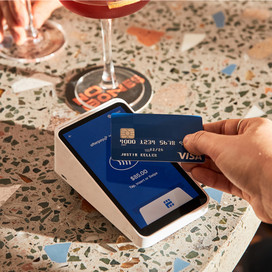Table of contents
In today’s digital world, if a customer doesn’t have a form of payment in hand, they can still make purchases. How? Making a purchase without being physically present is called a card-not-present (CNP) transaction.
What is a card-not-present transaction?
A card-not-present (CNP) transaction occurs when neither the cardholder nor the credit or debit card is physically present at the time of the transaction. It’s most common for remote orders – online, over the phone or by mail.
A transaction is only considered ‘card present’ if payment details are captured in person at the time of the sale. This occurs when cards are physically tapped to a contactless reader or a PIN is manually entered into a card reader by the customer.
Examples of card-not-present transactions
There are a number of CNP transactions that you probably come across every day. They include:
- Online purchases: When a customer buys goods on the internet or through an eCommerce transaction.
- Buy online, pick up in-store: When a customer collects the order in person rather than opting for delivery.
- Phone orders: When a customer provides the credit or debit card information to your business over the phone.
- Recurring payments: Payments that are set up to bill automatically.
- Invoices: Online payments.
How much does it cost to process credit and debit cards remotely?
Just like processing credit and debit cards in person, your business will have to pay to process CNP payments. As a refresher, the three main types of credit and debit card processing fees that make up your rate are interchange and assessment fees (charged by card brands like Visa, Mastercard and American Express), industry certification and risk-related costs, and your payment provider’s markup.
Generally, interchange fees are higher for CNP transactions because the chance of fraud and chargebacks is higher without the card present. These higher processing costs are then passed down to the merchant, which is why card-not-present transactions are usually more expensive than card-present transactions.
What are card-not-present fraud and chargeback fraud?
Card-not-present fraud is a type of card scam in which a defrauder uses someone else’s compromised card information to make a purchase remotely. Because both the card and cardholder aren’t physically present, it can be difficult for merchants to verify the purchaser’s identity.
In the 2022–23 financial year, card fraud totalled $677.5 million in Australia, with CNP fraud accounting for 90% of all fraud on Australian cards. This number has been rising steadily in recent years, highlighting the ongoing challenge posed by the rapid growth of digital and remote business operations, and the significant increase of card payments for online transactions.
Chargeback fraud is another type of scam where a customer falsely claims to have received a defective product or no product at all. Instead of contacting the merchant for a refund or replacement, the customer initiates a chargeback with their bank, in effect reversing the payment. This type of scam exploits the chargeback process designed to protect consumers.
How to prevent card-not-present fraud and chargeback fraud
As a business owner, there are several ways to protect against CNP fraud, including implementing both best practices and security measures. It’s important to take proactive steps to prevent card fraud, especially with CNP transactions. You can read our article for practical advice on how to spot and avoid suspicious transactions.
The card verification value (CVV) is a commonly used method for authenticating CNP transactions. The CVV number is printed on the physical credit or debit card, meaning a customer must have the card to enter the number. Most payment processors incorporate CVV checks to enhance transaction security.
Another effective method is the address verification system (AVS), which compares the billing address of the credit or debit card given by the customer with the address on file at the bank or card provider. This is why most payment processors, including Square, will ask you to verify your customer’s billing address before authorising a CNP charge, adding another layer of protection against fraudulent transactions.
To reduce the likelihood of fraudulent claims, consider improving customer service to address issues before they escalate, and having clear return and refund policies to simplify the process for customers. Using secure payment processors like Square can also help protect your business from fraudulent disputes. Square’s fraud monitoring and dispute management services allow you to focus on running your business while it handles payment security.
4 easy ways to accept and process CNP payments with Square
With Square, there’s no need to sign up for a separate card-not-present merchant account to process online payments. Here are some of the affordable ways to process CNP transactions with Square.
- Utilise Square Invoices. Invoices are a strong option for customers who don’t feel comfortable disclosing their payment details over the phone.
- Send Square Payment Links. This generates a simple online checkout link or button. Just create a link with your item name and price, and share the link on your existing website, social media channels, or in an email. Learn how to get started with Square Payment Links.
- Manually enter card information using Square Virtual Terminal or Square app. This is ideal for orders taken remotely or over the phone. You can manually enter card information on your Square app or use Square Virtual Terminal on your computer.
- Implement Square’s eCommerce API. This allows you to process payments with Square on your own website.
Process a card-not-present transaction with Square Virtual Terminal
Square Virtual Terminal is a product offered by Square that lets you safely process credit and debit cards over the phone. Simply open your Dashboard and turn any computer into a virtual point-of-sale (POS) system – no card reader or software needed. The Square card-not-present transaction fee when you manually type in payments is 2.2%.
Here are the steps to process a CNP transaction on Square Virtual Terminal:
- Sign up for your free Square account.
- From your Square Dashboard screen, in the left-side panel, go to Virtual Terminal > Take a Payment.
- Under Payment Method, select Manually Enter Card.
- Enter the credit or debit card details for the transaction. You will need to enter the final order amount along with the customer’s card number, card expiration date, CVV and billing postcode. (The optional note field is great for leaving a personal thank-you or to detail items.)
- Click Charge.
Process a card-not-present transaction with manual entry
Here are the steps to process a CNP transaction in the Square Point of Sale app:
Open the Square Point of Sale app and follow the steps below to minimise the risk of payment disputes when making card-not-present transactions. The manual card entry fee is 3.5% + 15 cents.
- Open the Square Point of Sale app and add items to the sale.
- Tap Charge.
- Tap Manual Card Entry.
- Enter the customer’s card number, card expiration date, CVV and billing postcode.
- Tap Charge.
Process a card-not-present transaction with Square Online, Payment Links, eCommerce API or Invoices
When a customer makes a purchase through Square’s other CNP transaction methods – such as your Square Online store, Payment Links and eCommerce API – or pays an invoice online, the fee is 2.2%.
![]()











